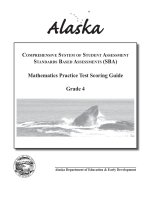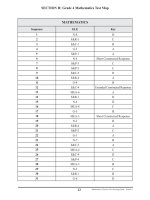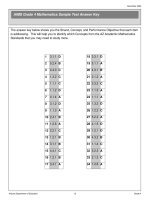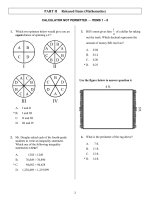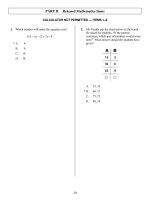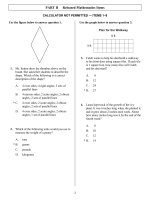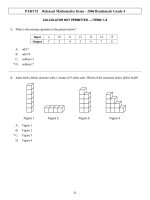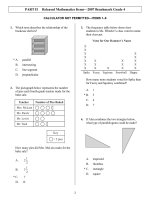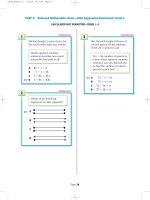Grade 4 math illinois 11 answers
Bạn đang xem bản rút gọn của tài liệu. Xem và tải ngay bản đầy đủ của tài liệu tại đây (168.75 KB, 3 trang )
2011 ISAT Grade 4 Sample Book
Answer Key with Assessment Objectives Identified
Item
Number
Correct
Answer
Assessment Objective
1
B
6.4.01 Read, write, recognize, and model equivalent representations of whole
numbers and their place values up to 1,000,000.
2
C
6.4.02 Identify and write (in words and standard form) whole numbers up to
1,000,000.
3
C
6.4.04 Represent multiplication as repeated addition.
4
B
6.4.05 Order and compare whole numbers up to 100,000.
5
C
6.4.06 Order and compare decimals through hundredths.
6
A
6.4.07 Order and compare fractions having like denominators with or without
models.
7
B
6.4.08 Identify and locate whole numbers, halves, and fourths on a number
line.
8
A
6.4.09 Solve problems involving descriptions of numbers, including
characteristics and relationships (e.g., odd/even, factors/multiples, greater
than, less than).
9
C
6.4.12 Model and apply basic multiplication and division facts (up to 12 × 12),
and apply them to related multiples of 10 (e.g., 3 × 9 = 27, 30 × 9 = 270, 6 ÷ 3 = 2,
600 ÷ 3 = 200).
10
A
6.4.13 Model situations involving addition and subtraction of fractions with
like denominators.
11
D
6.4.14 Solve problems involving the commutative and distributive properties
of operations on whole numbers
[e.g., 8 7 7 8, 27 5 (20 5) (7 5)].
12
C
6.4.16 Make estimates appropriate to a given situation with whole numbers.
13
C
6.4.16 Make estimates appropriate to a given situation with whole numbers.
14
C
7.4.01 Solve problems involving elapsed time in compound units (e.g., 1 hour
and 40 minutes) that occur in the same half day (a.m. only or p.m. only).
15
D
7.4.02 Select and use appropriate standard units and tools to measure length
(to the nearest ½ inch or ½ cm), time, and temperature.
16
D
7.4.03 Solve problems involving the perimeter of a polygon with given side
lengths and the area of a square, rectangle, or irregular shape composed of
rectangles using diagrams, models, and grids or by measuring (may include
sketching a figure from its description).
17
C
7.4.04 Compare and estimate length (including perimeter), area, volume, and
weight/mass using referents.
18
C
7.4.05 Determine the volume of a solid figure that shows cubic units.
53
2011 ISAT Grade 4 Sample Book
Item
Number
Correct
Answer
19
C
7.4.06 Solve problems involving unit conversions within the same
measurement system for time, length, and weight/mass.
20
C
8.4.01 Determine a missing term in a pattern (sequence), describe a pattern
(sequence), and extend a pattern (sequence) when given a description or
pattern (sequence).
21
A
8.4.02 Write an expression using letters or symbols to represent an unknown
quantity.
22
D
8.4.03 Evaluate algebraic expressions with a whole number variable value
(e.g., evaluate 3 m when m 4).
23
D
8.4.04 Identify or represent situations with well-defined patterns using words,
tables, and graphs (e.g., represent temperature and time in a line graph).
24
A
8.4.05 Translate between different representations (table, written, or pictorial)
of whole number relationships.
25
A
8.4.07 Solve for the unknown in an equation with one operation
(e.g., 10 = + 3 + 2,
– 1 = 3).
26
A
9.4.01 Identify, describe, and sketch two-dimensional shapes (triangles,
quadrilaterals, pentagons, hexagons, and octagons) according to the number
of sides, length of sides, number of vertices, and right angles.
27
C
9.4.02 Identify and describe three-dimensional shapes (cubes, spheres, cones,
cylinders, prisms, and pyramids) according to their characteristics (faces, edges,
vertices).
28
B
9.4.03 Differentiate between polygons and non-polygons.
29
D
9.4.05 Identify whether or not a figure has one or more lines of symmetry, and
sketch or identify all lines of symmetry.
30
A
9.4.06 Identify images resulting from flips (reflections), slides (translations), or
turns (rotations).
31
B
9.4.09 Identify the two-dimensional components of a three-dimensional
object.
32
A
9.4.10 Identify a three-dimensional object from its net.
33
B
9.4.11 Predict the result of composing or decomposing shapes or figures.
34
C
9.4.12 Identify congruent and similar figures by visual inspection.
35
D
10.4.01 Read and interpret data represented in a pictograph, bar graph,
line (dot) plot, Venn diagram (with two circles), tally chart, table, line graph, or
circle graph.
Assessment Objective
54
2011 ISAT Grade 4 Sample Book
Item
Number
Correct
Answer
Assessment Objective
36
D
10.4.01 Read and interpret data represented in a pictograph, bar graph,
line (dot) plot, Venn diagram (with two circles), tally chart, table, line graph, or
circle graph.
37
B
10.4.01 Read and interpret data represented in a pictograph, bar graph,
line (dot) plot, Venn diagram (with two circles), tally chart, table, line graph, or
circle graph.
38
A
10.4.03 Determine the mode and range, given a set of data or a graph.
39
C
10.4.04 Classify events using words such as certain, most likely, equally likely,
least likely, possible, and impossible.
40
B
10.4.05 Describe the chances associated with a context presented visually,
including using the response format “3 out of 4” or 3 4 .
To view all the mathematics assessment objectives, download the Illinois Mathematics Assessment
Framework for Grades 3–8 online at www.isbe.net/assessment/IAFindex.htm.
55
